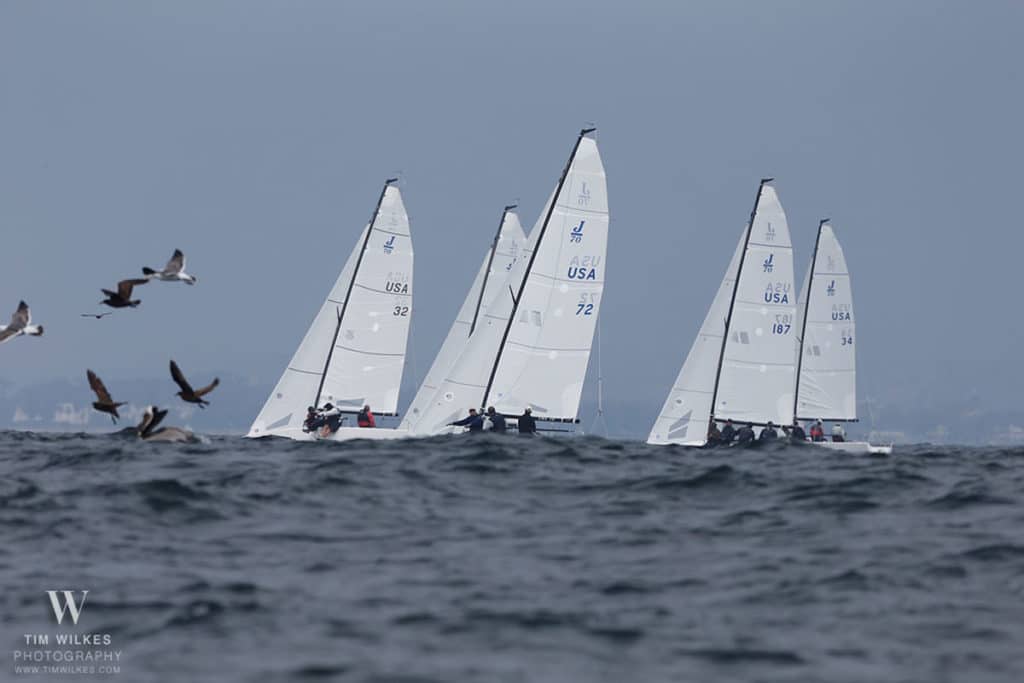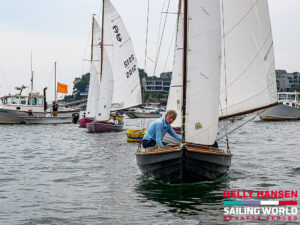I’ve been sailing in San Diego for 23 years on all sorts of boats, from Snipes to J/24s and Etchells so I’ve spent plenty of days on the South Bay and off Point Loma. Luckily for NOOD racers spring is the windiest time of year in San Diego and it’s the one season where we can experience the most variety in the winds in which we sail. We can get the classic sea breeze, but we also get more frontal-based winds driven by the fronts that come all the way down from the north, stop near Southern California, and then peter out.
If the set up is pre-frontal, winds will be from the south, and then after the front clears out winds will transition back to the northwest. So it’s important for anyone not familiar with the area to pay close attention to the weather forecast and note the gradients and the overall movements of the regional weather systems. One other thing to consider is that the water is as cold as it’s going to get, in the mid 50s, so that contributes to stronger sea breezes and potentially cool temps on the water.
Let’s cover the ocean courses first. The general tendency is for the wind to shift right during the course of the day, this will tend to be a persistent shift scenario where the right side of the course will be favored for a leg, or even an entire race. How strong this tendency is has a lot to do with the influence of Point Loma. The windiest scenario in San Diego Bay is when there’s a sea breeze, and as the breeze comes over the hill it accelerates. So, if the course is relatively close to Point Loma with a sea breeze, the right will be strongly favored. The further south you move, the lesser the influence of Point Loma and both sides of the course can pay.
When racing on the ocean course, the morning breeze will be your most important observation. If the wind is due south, at 180 degrees, that’s a direction where the left can be favored significantly. If it’s around 200 to 220 degrees, the left can be powerful still, but it’s not a sure thing.
The further right the wind gets—say to 250 degrees and above—the right will be more powerful. We’re talking about a 60 to 70-percent chance of the right working best.
The old saying is that, if there’s dew on the grass when you wake up you can expect a sea breeze, which seems a pretty accurate predictor here. Another good indication is when you get to the racecourse around 10:30, the marine layer will clear off relatively early and you’ll see clouds slowly building on the mountains behind the city. As the sea breeze builds, the wind will march right slowly, but you’ll get pressure puffs from top left as you approach the mark. If you have a northerly in the morning you’ll likely have wind to sail out in, but it’s kind of unusual. If this is the case, it’s good to know how strong the northerly gradient is. Either way, look for it to shift back to the westerly. Another unlikely scenario is the Santa Ana wind. The locals know all about it and you’ll hear about it on the morning weather if it’s happening. This strong offshore wind is created by high pressure over southern Nevada. The coastal area will either be a convergence zone where the Santa Ana fights the sea breeze; which makes for tricky light-air racing, or it’s more inline with the coastal northerly. In this case the sea breeze will reinforce the Santa Ana.
There is current for sure, and it generally flows down the coast from northwest to southeast. It’s influenced by the California Current 20 to 30 miles offshore, so it tends to move in and out. Some days there’s next to no current and other days it can be quite strong. The key is to get out there early and check the current at the windward mark. Look to the kelp lines for clues as to how it’s running. Also, keep an eye the regional weather two to three days out from the regatta: if it’s 48 hours of 25 knots off Point Conception to the north, an eddy south of San Diego will form. When this happens the breeze comes out of the south very light, and there will definitely be current.
ON THE SOUTH BAY Sailing on the South Bay Course is more like lake sailing than ocean sailing because you’re in an enclosed body of water and surrounded by land so the wind tends to shift more than offshore. In the standard southwesterly sea breeze the mark will be near what’s called the Silver Strand—the long ribbon of sand on Coronado. The wind tends to accelerate as it flows over the beach, so what will happen is you’ll start the race and the boat either to windward or leeward will start to sheer away. The key is to be patient, however, because it typically does oscillate.
The wind will shift persistently over the course of the day, but it will do so in fits and starts.
As it goes right (west) it will start blowing from Coronado Bridge, orientating the racecourse parallel to the ship channel, which is quite deep near the navy ships. When, and if, this happens, pay particular attention to the current and know what the tides are doing. If the tide is ebbing (toward the bridge), there will be more favorable current on the right side of the course.
On the bay course, playing the middle is typically not the best approach. Instead, as with any other venue, you want to stay with the shift as it moves slowly, and make sure you have your nose well into the next shift before you tack. Patience is the key here as the shifts tend to net out. For wind-direction visuals, there are flags on the Strand and on the bows of the navy ships. Not that many.
Also, because the wind is being accelerated over the Strand it tends to come down in good size patches so you want to be looking to position yourself when sailing downwind in front of the next line of wind coming down and keeping your air clear.
One final and important note for visiting teams: Be aware in both race areas, and more so on the outside courses, that there will be significant kelp, so have a way to clear off your foils easily.










